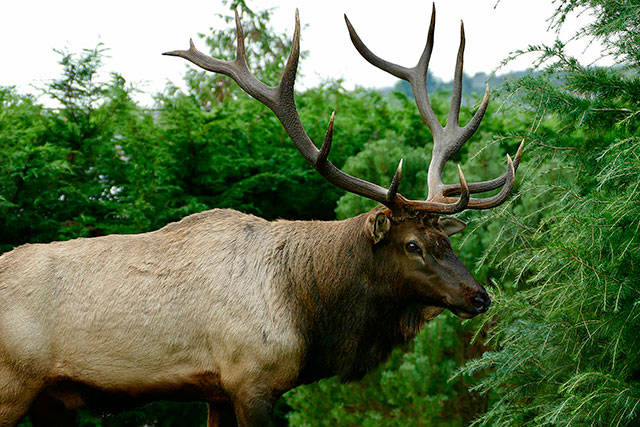Whidbey Island’s newest nature preserve, the Donald Borgman Nature Preserve, already comes with a ringing endorsement. Bruiser appears to love the place.
One of the playgrounds of Whidbey’s lone resident elk, nicknamed Bruiser, is now permanently protected thanks to a lifelong islander’s love for his idyllic property.
Donald Borgman, third-generation owner of a 127-acre farm near Strawberry Point on North Whidbey, recently donated 88 acres to the Whidbey Camano Land Trust for a wildlife preserve.
He also donated an agricultural conservation easement on the remaining 39 acres, so the main farmstead continues to support agriculture.
The generosity of Borgman permanently protects a peaceful property that appears frozen in time from the days when Oak Harbor was largely a farming community. Aside from the beautiful pastoral and mountain views, the preserve also features a mosaic of wildlife habitats, including freshwater wetlands, coniferous and deciduous forest, and open fields.
It was a wonderful opportunity for the Land Trust to protect a large, contiguous area for habitat conservation that has far reaching benefits. The habitat certainly has Bruiser’s stamp of approval. The majestic bull elk has lived in the rural Strawberry Point area since the fall of 2012 after swimming across Skagit Bay.
“Bruiser is spotted frequently on and around our new wildlife preserve,” said Ryan Elting, the Land Trust’s conservation director.
“It’s definitely an important part of his home range,” which covers a large portion of Strawberry Point, according to neighbors and wildlife experts.
Birds and other wildlife are quite fond of the place, too. A year-long survey conducted on the Borgman property by Jay Adams and Ruth Richards of the Whidbey Audubon Society has already revealed 62 species of birds, including five different types of raptors and four kinds of woodpeckers, including the Pileated Woodpecker, a state at-risk species. The survey didn’t include the forested part of the property, which means a lot more species that depend on the wildlife preserve will be added to the list.
“What I noticed is it has a good diversity of habitat with a lot of hedgerow edge, which is important for lots of birds and wildlife. And, there are some huge maples and alders in that forest area,” commented avid birder Sarah Schmidt, who recently recorded 27 species of birds at the preserve on just one afternoon in June.
The Land Trust raised $75,000 from private donations, including a $10,000 donation from the Whidbey Audubon Society, so the Land Trust could pay for a myriad of costs and accept the land and easement donations.
The Land Trust still needs to secure funding to provide public access to the preserve, according to Pat Powell, the organization’s executive director. Plans include creating a small parking lot and about a mile of hiking trail winding through the wildlife preserve. Depending on fundraising success, it might take up to two years before the preserve is open to the public.
The Land Trust also is exploring ways to expand the preserve, protecting even more wildlife habitat and creating more ways for visitors to experience the outdoors.
“The Donald Borgman Nature Preserve will be a great place to get out in nature in an area of north Whidbey Island that doesn’t have enough of that,” Elting said. “There is an opportunity to protect some more really fabulous and diverse habitat.” An urban wildlife grant has been submitted to the Washington State Recreation and Conservation Office to help make this vision a reality.
In the meantime, the Land Trust is working on a management plan for the preserve, placing emphasis on the needs of wildlife, including its most regal inhabitant who is believed to be just under 800 pounds and 5 ½ feet tall at shoulder height.
“We’re certainly considering Bruiser and how to least impact him in our planning for the preserve,” Elting said.
Elting got his first look at the massive elk during a visit to the property in early June. He was busy clearing a path with a weed trimmer for an upcoming tour when Bruiser suddenly rose up from the tall grass less than 200 feet behind him.
“Ryan was running the weed-whacker and Bruiser was just standing and watching,” Schmidt said.
Finally, a tossed object got the attention of Elting, who turned around, quickly shut off the trimmer and then marveled at the animal, who slowly wandered off.
“My hands were shaking, and I’m not sure if it was from the sight of Bruiser or the weed-eating,” Elting said. “He is magnificent!”
“I’ve never been that close to an elk,” Schmidt said. “He’s big. He was a pretty impressive animal.”
How long Bruiser will be around is difficult to say, according to Ralph Downes, enforcement officer with the Washington Department of Fish and Wildlife. Downes estimates that Bruiser is about 11 years old. In the wild, the average life expectancy for a bull elk is around 12 to 15 years, but in captivity, animals will sometimes exceed 20 years, Downes said.
“If he can mellow a bit during the rut, Bruiser may have many more years with us,” Downes said.
• The Whidbey Camano Land Trust is a nonprofit nature conservation organization that actively involves the community in protecting, restoring, and appreciating the important natural habitats and resource lands that support the diversity of life on our islands and in the waters of Puget Sound. For more information, visit www.wclt.org, email to info@wclt.org, or call 360.222.3310.



